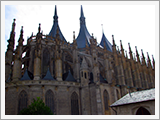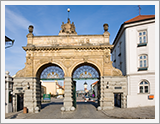TRIPS - TO THE CZECH REPUBLIC
| BRNO | |
 |
Brno, the capital of Moravia offers many cultural monuments worth mentioning Špilberk castle, on the hill Petrov - Diocese and Peter and Paul Cathedral in Gothic-Romanesque style with Gothic Revival double spiers. From the town fortifications only Menín Gate has been preserved. The gothic church of Saint Jacob is interesting with 92m high tower, the Jesuit church of the Assumption of the Virgin Mary and the Cistercian monastery in Old Brno from the turn of the 10th and 11 century are the most imposing religious buildings in Brno. The Church of the Assumption of the Virgin Mary from 1322, which was since 1782 the Augustinian monastery it was also location for JG Mendel, the founder of genetics. It is also possible to visit the functionalist Tugendhat Villa, which is registered on the list of UNESCO (tour has to be reserved in advance!). |
| ČESKÝ KRUMLOV (UNESCO) | |
 |
The medieval town is surrounded by the meandering river. The dominant of the town is the castle, in comparison to Prague Castle it is the second largest castle complex in the Czech Republic. Renaissance castle consists of Lower castle with tower and Upper Castle. There is unique bridge on the mantle, which connects the castle with the castle garden. The garden was founded in the 16th century and covering an area of 10 ha, it can be seen there the Cascading fountain, baroque villa Belárie or rotary auditorium for theater in the open countryside. Also noteworthy baroque castle theater in which are preserved in addition to the auditorium, orchestra pit, stage, stage equipment (the machinery), decorations, costumes, lyrics, librettos also accounts and inventory. Under the castle Latrán with gothic houses or Plešivec - the historic suburb of Ceský Krumlov can be visited. |
| DĚTĚNICE - castle | |
 |
Originally a wooden fortress was turned into a medieval gothic castle of which towers and gothic cellars are still preserved. After many renovations the late Baroque style of the castle has been preserved to this day. In 1948 the castle was nationalized and used as a boarding school, after 1991, when the equipment was moved, chateau began to dilapidate. In 1998-2000 it was completely renovated by new owner and it was open to the public. Near the castle there is a restored castle brewery with brewing museum and the famous medieval tavern. |
| HLUBOKÁ NAD VLTAVOU - castle | |
 |
The castle is one of the most beautiful in the Czech Republic. It got the romantic touch after the neo-gothic reconstruction by Schwanzenberg family, who in addition to repairs also established a large park. The tour of private rooms and luxurious ceremonial halls are open throughout the year. The Riding hall was rebuilt to Aleš South Bohemian Gallery. Besides the castle it can be seen the hunting castle Ohrada in the nearby of Munický pond. |
| KARLOVY VARY | |
 |
Karlovy Vary is the largest and most famous spa town in the Czech Republic. Their history dates back to the second part of the 14th century, when Karel IV. chased on horseback in the local woods and his retinue by chance discovered a hot spring. Of the 79 springs, the spa used 13. The most famous is the Hot Spring (73 ° C), splashes of up to 12 m in the Vrídelní Colonnade. Other springs can be found in the Mill Colonnade, which was built by Josef Zítek in Wooden Market Colonnade and the Castle Colonnade. The historic spa buildings are mostly from the 19th century. The amount of walking paths is complemented by the Tower Diana from 1914, Goethe's viewpoint from 1889 and the oldest Charles IV viewpoint from 1877. Karlovy Vary is also famous thanks to celebrity visits (Beethoven, Franz Josef I., Paganini, Chopin, Mozart, Gogol, Tyl, J.E. Purkyne, Freud). |
| KARLŠTEJN - castle | |
 |
Gothic castle founded in 1348, occupies among Czech castles exceptional position. The castle was built by Czech King and Roman Emperor Charles IV., as a place for safekeeping of the royal treasures, especially Charles's collection of holy relics and the coronation jewels. In the past the imperial coronation jewels and holy relics, later also Czech crown jewels were kept in the Chapel of the Holy Cross. |
| KONOPIŠTĚ - castle | |
 |
Originally Gothic impregnable fortress founded by the family Benešovic 700 years ago. Since 1887, the magnificent residence of the Austrian throne successor Franz Ferdinand d'Este. Interiors with rich collections - Esten collection of weapons, hunting trophies, St. George Collection. |
| KONOPIŠTĚ - golf | |
 |
New eighteen-hole course spread d'Este Golf Resort Konopište offer for golfers to master thirty-six holes. Course is considerably shorter than the older Radetzky - a par 72 and length 6086 from the white tees - but remain a common feature of a wide and clear fairways and large greens and shaped. The specialty courses d'Este, which bears the name of Archduke Ferdinand d'Este, is an island green hole number 9. |
| KUTNÁ HORA (UNESCO) | |
 |
In the Middle Ages, Kutna Hora was the most important town after Prague due to extensive mining of silver. Dominating the five-aisled Gothic cathedral of St. Barbara was founded as a mining temple and dedicated to their patron St. Barbara. The interior is decorated with well-preserved Gothic and Renaissance paintings. Construction was completed at the turn of the 19 to 20 century. Other attractions in Kutna Hora include mint, Vlašsský Court, Branská tower and chapel in the castle complex. In nearby Sedlec you can visit Cemetery Church of All Saints with charnel-house and the Cathedral of the Assumption of the Virgin Mary in Cistercian monastery complex. |
| LEDNICE - castle (UNESCO) | |
 |
Romantic castle surrounded by canals served by the Liechtenstein family as a summer residence. We can find there grand ceremonial rooms, dining rooms and sumptuous bedrooms. Around the castle you can visit the castle greenhouse, park with a collection of rare trees, Minaret, and John Castle-hunting mansion, which was built like a fake ruin. |
| MARIÁNSKÉ LÁZNĚ | |
 |
Spa town was founded in 1805, from 1992 is situated in the conservation area. Mineral springs are known since the Middle Ages, in town there are 40 springs, in the area nearly 100, are used to treat kidney, skin, nerve, joint and respiratory diseases. Tepel monastery abbot Karel Kaspar Reitenberger, physician Jan Josef Nehru and architect Václav Skalník had merit in spa foundation. During the 19th century town gained European fame. Very important building is the Colonnade Maxim Gorky with unique decorations and popular Singing Fountain that every odd hour plays one of the many famous songs. |
| PLZEŇ | |
 |
Among the most important monuments of western metropolis the historic core of the city is included, which is now protected as urban conservation. Dominating the town is the Gothic Church of St.Bartholomew, highest in the Czech Republic, thanks to 102m high tower. Besides him, there are religious monuments -Franciscan monastery with the Church of the Assumption of the Virgin Mary and Baroque building Dominican convent with Church of St. Anne. You can also visit the largest synagogue in the Czech Republic-Great Synagogue and the Old Synagogue. There are also zoo garden and arboretum Sofronka. It is also possible to visit the Pilsner Urquell brewery tour and Gambrinus brewery, which are in the unique industrial heritage (ERIH). |
| TELČ (UNESCO) | |
 |
The historic city center is one of the most valuable urban conservation in Moravia and in the 90´s it was included in the list of UNESCO. Dominant of the town is the Renaissance Telc Castle, which, thanks to its preserved original interiors, it is the pearl of the Moravian Renaissance. |
| TEREZÍN | |
 |
The city was founded by Joseph II. like a military fortress in 1780 and named after Empress Maria Theresa. Brick fortification complex is surrounded by water ditches, bastions, courtines and ravelines. Militarily unimportant fortress was abolished 1882. In the 2nd World War the fortress was converted into a Jewish ghetto (The Fortress) where the Nazis took the Jewish population from the streets to liquidation camps. Small Fortress was infamous prison of the Prague Gestapo. Terezin Memorial is currently located in the Small Fortress, it is a cultural monument. |








